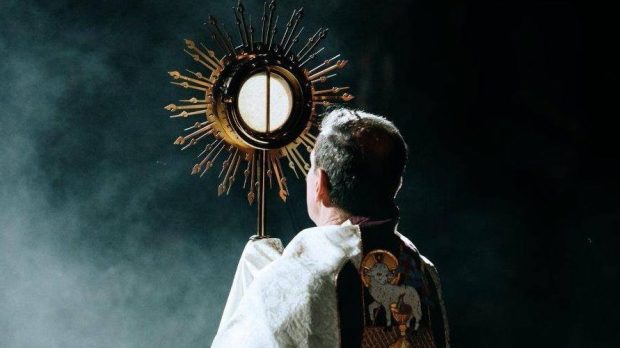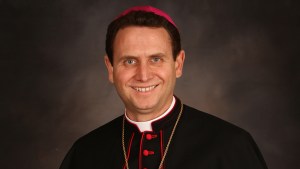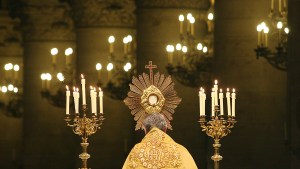When the Catholic bishops of the United States gather for their biannual meetings, their agenda might contain little of interest to the media, or they might be discussing things that make for a media frenzy. A notable example of the latter was their Dallas meeting in 2002, when Church and society were eager to see how Church leaders would respond to the emerging clergy sexual abuse scandal.
This year, in spite of protests from the bishops’ official spokespersons, many media outlets held on to the narrative that they were coming out with a statement condemning pro-abortion Catholics who hold public office.
Thus, “The Mystery of the Eucharist in the Life of the Church,” the statement they ultimately voted on, got its 15 minutes of fame, but journalists had to dig for any hint that it was a call to deny Communion to the second Catholic president of the United States or others who fight to keep abortion legal.
The bishops, of course, want the statement’s message to get out there and help restore Catholics’ faith in the central sacrament of their Church, three years after a Pew study suggested that that faith is seriously waning.
“I don’t want it to be sitting on the shelf,” said one spokesman for the United States Conference of Catholic Bishops, Bishop Michael F. Burbidge of Arlington, Virginia (pictured above).
Bishop Burbidge, who on December 6 will celebrate his fifth anniversary as head of the Arlington Diocese, just outside Washington, D.C., is the former Chairman of the USCCB Committee on Communications. He spoke with Aleteia just before Thanksgiving about the new Eucharistic statement, the bishops’ work on a Eucharistic revival, evangelization, and his own approach to dialogue with Catholics who hold political office.
During the USCCB Fall General Assembly, much of the attention paid was to the new statement on the Eucharist. So how can people find it if they want to read it?
It’s on the USCCB website. It’s an easy read. I’ve encouraged my parishioners in the Diocese of Arlington to not just read the headline but to read the document itself. And it’s written in such a way to make it very manageable for people to do.
How is a new document going to help us reach people about the Eucharist?
I think a document is just one tool in the toolbox. To reclaim in our Church a Eucharistic wonder or awe, a firm belief in the real presence, the importance of being at Mass, I think a document helps in that it teaches what the Church has always taught. The teaching doesn’t change, but how we present it should always be made more fitting to the times. For example, this document would use the example of various saints who have had a great love to the Holy Eucharist that may be an inspiration to younger people or different people.
So the document is just one tool. We talked a great deal throughout our meeting about a Eucharistic revival within our country, spending the next three years preparing for a national Eucharistic congress where we have people from all over the country coming together.
As a bishop, how do you foresee using this statement in your own diocese?
In Arlington, we are getting ready for the 50th anniversary of our founding as a diocese, in 2024. I did not want to just wake up in 2024 and celebrate. I said, “We’re going to have three years of preparation to get ready for this.” And the first year, I’ve decided, we would devote to the Eucharist. So all of our diocesan events and celebrations and conferences and talks would be on the Eucharist and living a Eucharistic life. So it’s very providential.
So this document will be distributed in our parishes and schools, with the hope of people breaking into small groups, maybe different sections, maybe reflection questions, to kind of digest it and talk about it. Certainly we’ll make it a teaching document for our schools, but hopefully as opportunities for people to reflect upon it. I don’t want it to be sitting on the shelf.
The document comes not only in the wake of the election of our second Catholic president, as many have harped on, with the question in the air of denying Communion to a Catholic public official who is also pro-abortion, but in the wake of pandemic-required lockdowns, when many Catholics could not receive Communion for months. What has been your experience in the Diocese of Arlington vis a vis people’s renewed sense of the Eucharist, following a long absence?
First of all, the document was never intended to target any individual or groups of people. It was always a part of our 2021-2024 strategic plan, which was actually called “Created Anew by the Body and Blood of Christ.” So, a source of healing and hope. Again, as one of the ways to implement the strategic plan, the document was meant to be a resource for that. Whenever you talk about the Eucharist, you talk about it as a precious gift. We say when we prepare to receive it, “Lord, we are not worthy.” It’s a gift that God gives to us. But we are called, as the Church has always taught, to put ourselves in the right disposition, to be in union with the Lord and his Church and not separate ourselves from that. So none of us can ever free ourselves from that responsibility. We have to be in that state of grace, with no grave mortal sin. So that document speaks to all Catholics.
Now again, to answer your question, the timing is very providential, because there are two concerns that we have as a Church. The pandemic did necessarily dispense people from the obligation to attend Mass, for the health, the well-being of everyone. So people began to view Mass from their living rooms and live stream and make Spiritual Communions.
But we’re trying to explain: nothing takes the place of actively, fully participating in real time and actually receiving the body and blood of Christ, which you can’t do via live stream. So this is a time I say to our faithful, if you are at a point in your life in the midst of the challenges of this pandemic that you’ve decided it’s okay to go to a restaurant, it’s okay to go to the mall, it’s okay to go to family gatherings, then that same principle must be applied to your spiritual life. And we understand that right now some people who physically are compromised, or emotionally are not able to go to malls, to go to sporting events, of course, we never would expect that of them as it applies to their spiritual lives. But what we’re beginning to see is a real yearning for people to be back to the Eucharist. People are just at the point now where we really do need each other. It’s not back to where we were, but I certainly think it’s heading in that direction.
Any concrete examples of people you’ve spoken to who’ve expressed that longing, that joy to be back in church?
Definitely. Whenever I go to our parishes, one of the first things I hear as I greet the people is “Bishop, isn’t it so good to be back together. I never knew how much we needed each other and how much we could take that blessing for granted.”
I was thrilled just a few weeks ago, where we had scheduled a diocesan pilgrimage to the Basilica of the National Shrine of the Immaculate Conception at the end of October, which holds over 2,000 people. A few weeks before, because of the restrictions in Washington of still having to wear masks — the cafeteria was closed, all those kinds of things — I said, “I don’t know, should we still be doing this?” And my team said, “Yes, let’s just do it, and the people who want to be there will be there.” When I walked down the steps to enter to celebrate the Mass, I had chills. There was standing room only. And this was just people from the Diocese of Arlington who traveled from various regions. There were tears when the bishops, the priests entered. It was the first time where we really felt that as a body we were all together. I had chills, and walking down the aisle I saw the tears of the people.
That’s probably one of the most powerful recent examples. We just had a big kickoff celebration the Sunday before Thanksgiving, with solemn Vespers, to start our preparation for our golden jubilee, at 4 o’clock on a Sunday afternoon. I really wasn’t expecting that large of a crowd. Again, we almost filled the cathedral.
So that longing’s there.
During the bishops’ Fall General Assembly, Archbishop William E. Lori of Baltimore thanked Bishop Andrew H. Cozzens because all the work he and his team are doing on the Eucharistic revival has had evangelization as its focus. What are some things that you have found works in evangelizing efforts? How do we talk to people? What are the keys to reaching fallen-away Catholics?
Bishop Cozzens is certainly a wonderful example of someone who excels in this area. His enthusiasm for this Eucharistic revival is just incredible. Bishop Robert Barron is another example.
What you hear from them, and I know in my own diocese, where we’re trying to evangelize, reach out to those maybe who are not engaged in the faith, is a wonderful program — and this is at the heart of evangelization — and it’s called Truth, Beauty and Goodness.
This is at the heart of evangelization — it’s called Truth, Beauty and Goodness
Bishop Michael F. Burbidge
Maybe to get people back to church, maybe for some it would be a nice clear document of the sound teaching of the Church on the Eucharist, like the one we issued. Maybe that won’t work for some people. Maybe the door for other people would be the beauty of the Church in its art, its history, its tradition, that just opens a door for some people to the sacred. But maybe for some people, they’re not there yet either, and it’s goodness, like “Would you join us in participating in our food collection, where we’re going to help so many people, where we’re going to help refugees who are settling in our diocese.” And maybe that’s the door.
You can’t just try one way of doing things. You must use various means. Same thing with communications. I’m very proud of Billy Atwell [the Arlington Dioceses’s Director of Communications] and his team here. We are where the people are out in social media. We have a diocesan newspaper. That really works well for some people. For some people it doesn’t. So we’re using all the appropriate tools. You’ll see us on Facebook and on Instagram. I do a podcast, and we do spots on the radio. So you have to try new and effective ways. And monitor it. Billy’s team does a great job: “Hey, listen, this is where it’s working. We’re getting a lot of response here. Or we’re not getting it. So let’s regroup this. Let’s do what works.”
The Gospel is not new; it’s the way of communicating it, and finding effective ways of doing it. That’s the new evangelization.
How do we talk to a generation that is increasingly filled with “nones”?
I think, again, I’d go back to truth, goodness and beauty. I think another way is what we’re doing at the direction of the Holy Father Pope Francis, I think with the nones, you have to listen to them. And that’s what we’re engaged in now, a synodal process. And the Holy Father is asking us now until June, to go out throughout our dioceses and listen to the people of God and people of good will — not asking them what doctrine or dogma has to change, but what is it that attracts you to the Church? What is it that maybe has led you away from the Church? What are some of the blessings we are experiencing? What are some of the challenges we are experiencing? The Holy Father has gone out of his way to say, “Please, Bishops, as you and your pastors go through this process, please give a great emphasis to those on the peripheries, to those who are no longer believing, to those who no longer are practicing their faith. Tell people: bring your families, bring your colleagues, bring your co-workers who are not with us and know that we’re here to listen to them.” That engagement leads to an encounter that can then allow us, God willing, to talk about the faith.
How can Catholics discuss real, everyday issues without leading to polarization?
We’re not spared. That’s the society, that’s the culture, that’s the air we are breathing today in our nation, so sadly. It is so polarized. How do we do it? I think Pope Francis is the one, actually in imitation of Christ, showing us how to do so: You engage with one another even when facing difficult, sensitive issues, with that willingness to listen, to say, “Help me to understand better where you are coming from in this position.” Avoid labeling, avoid dismissing, avoid harsh responses and be able to just treat each other with respect as a brother or sister in Christ. I do think the synodal process will be a great help along the way.
There was some discussion during the assembly about engaging Catholic political figures in dialogue over stances they hold that are contrary to their own Catholic faith. As someone who oversees a diocese so intimately tied to our nation’s capital, is there anything you can tell us about conversations you might have had with such legislators?
I could speak in general terms, not specifically, of course, for reasons of confidentiality. It’s an invitation to dialogue. It begins with an invite. As a bishop, especially in this diocese, I certainly have invited those who hold office to speak about the issues that are confronting us as a nation, and how our faith can be helpful in addressing that. It’s like any invitation: some may feel comfortable in accepting that invitation; others might not be there yet, and others might reject it.
But when there is that willingness to dialogue, I have found that, even though there may be strong disagreement, I always try to begin with telling political officials: the Church doesn’t belong to a political party. We are consistent in our teachings, especially in the Gospel of Life, and depending on the issue, that teaching is applied. So let’s find those areas, let’s see all the things that we do agree upon, where we in fact can work together as a Catholic Church to support this issue that is very important to you. And then, let’s have a sensitive conversation to say why we are far apart on this other issue. Again, help me to understand what is leading you to this position, and please allow me the opportunity to make sure that you understand not only what we are teaching as a Church, but why we are teaching it. And would you just give time to reflect and to pray upon this conversation. And I certainly would do the same with you.
So where there’s that openness to dialogue, even though we do not leave completely in agreement on every issue, I do think there have been numerous times where I do think we had a better understanding of each other.
So I would always welcome that opportunity. In the document on the Eucharist that the bishops passed it certainly reminds the bishops that they are to continue that work, and work to remedy any source or scandal or anything like that within the Church. I always try to see — whether it’s the president of a university or a political official or whatever — it’s one of God’s people. It’s a member of the faithful. And my job is to assist, with God’s grace and help, to show concern for their soul.
Where to read “The Mystery of the Eucharist in the Life of the Church”



